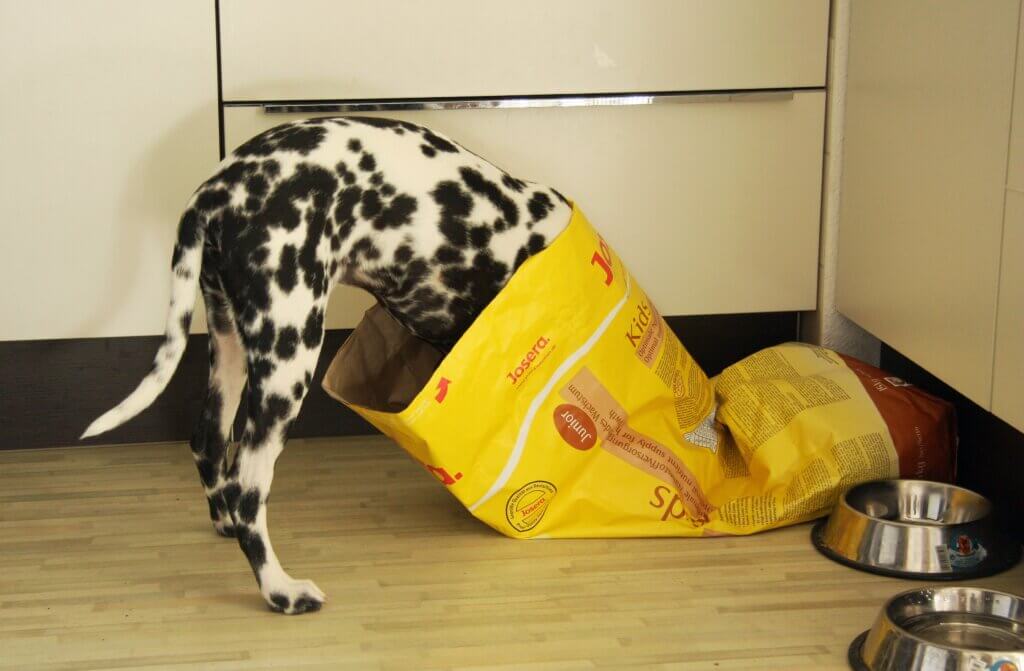How Much Does Dog Food cost?
Many pet owners ask this question, “How Much Does Dog Food Cost?” when they bring a new dog into their family or try to manage their budget. Understanding the cost of dog food is essential for planning and ensuring your pet gets the best nutrition possible.
In this blog, we will explore how much does dog food cost, considering various factors that influence these prices. We will also compare the costs of various dog food options, from dry kibble to raw diets. We will also look at the price differences between commercial and homemade dog food, helping you decide which option might be best for your budget and your pet’s health.
Additionally, we will discuss whether dogs need expensive food to thrive or if more affordable options can still meet their nutritional needs. By the end of this blog, you’ll have a comprehensive understanding of how much dog food costs and practical tips to save money without compromising on quality. We will also touch on why some dog foods are so cheap and provide advice on budgeting for a dog to help you manage all pet-related expenses effectively.
Average Cost of Dog Food by Type

Regarding feeding your dog, food prices might vary significantly based on the type and quality. Here’s a breakdown of the average costs for different types of dog food.
Dry Kibble
Cost per pound: The cost of dry kibble usually ranges from $1 to $3 per pound. Premium brands can cost more, often around $4 to $6 per pound.
Examples of popular brands and their price range:
- Pedigree: Approximately $1 per pound.
- Purina Pro Plan: Around $2 to $3 per pound.
- Blue Buffalo: Typically $3 to $4 per pound.
- Orijen: About $4 to $6 per pound.
Wet Canned Food
Cost per can and pound: Wet canned food is generally more expensive than dry kibble. Prices range from $1 to $3 per can, with the cost per pound typically between $2 to $5.
Examples of popular brands and their price range:
- Pedigree: Around $1 per can.
- Blue Buffalo Homestyle Recipe: Approximately $2.50 per can.
- Wellness CORE: About $3 per can.
- Merrick: Generally, $2.50 to $3.50 per can.
Raw Food Diets
Cost per pound: Raw food diets can be quite pricey, often ranging from $5 to $10 per pound.
Examples of popular brands and their price range:
- Instinct Raw: About $6 to $8 per pound.
- Stella & Chewy’s: Typically $7 to $10 per pound.
- Primal Pet Foods: Around $6 to $8 per pound.
Freeze-Dried and Dehydrated Foods
Cost per pound: Freeze-dried and dehydrated dog foods are also on the higher end, costing about $8 to $12 per pound.
Examples of popular brands and their price range:
- The Honest Kitchen: Approximately $10 per pound.
- Sojos: Around $9 to $11 per pound.
- Primal Pet Foods Freeze-Dried: Typically $10 to $12 per pound.
When choosing the right food for your dog, consider not only the cost but also the nutritional needs and preferences of your pet. Each type of food has its benefits and price points, enabling you to choose the best option that fits your budget and your dog’s dietary requirements.
Cost Comparison: Commercial vs. Homemade Dog Food

Choosing between commercial and homemade dog food involves considering multiple factors, including convenience, cost, and the nutritional needs of your pet. Here’s a detailed comparison of both options.
Commercial Dog Food
Pros and cons:
- Pros:
- Convenience: Commercial dog food is ready to serve, making it a sensible option for pet owners who are busy. There’s no need for preparation; you just scoop and serve.
- Variety: There is a wide range of flavours, formulations, and types (dry, wet, raw, freeze-dried) to suit different dietary needs and preferences.
- Balanced Nutrition: Commercial dog foods are formulated to fulfil the dietary guidelines established by governing authorities, such as the Association of American Feed Control Officials or AAFCO, for example, to ensure your dog gets a balanced diet.
- Cons:
- Quality Variation: The quality of commercial dog food can vary significantly. Some lower-end brands may use fillers, artificial additives, and lower-quality ingredients.
- Cost: Premium brands that use high-quality ingredients can be quite expensive.
Average monthly cost:
- Dry kibble: The cost varies ranging from $20 to $60 a month, based upon the type and quality.
- Wet canned food typically costs $50 to $100 per month due to its higher price per pound and the need for larger quantities.
- Raw food diets: These can be quite costly, ranging from $100 to $300 per month, as they use fresh, high-quality ingredients.
- Freeze-dried and dehydrated foods generally cost between $150 and $300 per month due to their extensive processing and high-quality ingredients.
Homemade Dog Food
Pros and cons:
- Pros:
- Control Over Ingredients: You have complete control over what goes into your dog’s food, allowing you to avoid fillers, additives, and preservatives.
- Customization: Homemade food can be tailored to your dog’s specific dietary needs and preferences, which is particularly beneficial for dogs with allergies or health issues.
- Quality: You can choose high-quality, fresh ingredients, making sure your dog has the healthiest diet possible.
- Cons:
- Time-Consuming: Making homemade dog food requires significant time for planning, shopping, and preparation. This can be challenging for busy pet owners.
- Nutritional Balance: Ensuring that homemade dog food meets all of your dog’s nutritional requirements can be difficult without proper knowledge and possibly consulting a veterinary nutritionist.
- Storage: Homemade food often needs to be refrigerated or frozen, requiring more storage space and planning.
Cost of ingredients: The cost can vary based on the recipes and the quality of ingredients. Here are some estimates:
- Basic recipes: The cost of using standard ingredients like chicken, rice, and vegetables is approximately $2 to $4 per pound.
- Organic or premium ingredients: The cost of organic or premium ingredients, such as grass-fed beef or free-range poultry, can range from $4 to $8 per pound.
Time investment and preparation cost:
- Time: Preparing homemade dog food can take 2 to 4 hours per week for shopping, cooking, and portioning meals.
- Preparation cost: This includes the cost of utilities (gas, electricity) for cooking and any special kitchen equipment (like food processors or storage containers). This can add $10 to $30 per month.
How Much Does Dog Food Cost by Brand?

Dog food prices might differ dramatically based on the brand and calibre of the components utilized. Here’s a breakdown of costs by brand category: budget-friendly, mid-range, and premium, along with a detailed cost analysis of some popular brands.
Budget-Friendly Brands
Average cost and quality assessment:
- Average cost: Budget-friendly dog food brands typically cost around $1 to $2 per pound for dry kibble and $1 to $2 per can for wet food.
- Quality assessment: These brands often use more fillers, by-products, and artificial additives. While they meet basic nutritional needs, they may not provide the highest quality ingredients.
Examples:
- Pedigree: Dry kibble costs about $1 per pound, and canned food is around $1 per can.
- Purina Dog Chow: Typically $1 to $1.50 per pound for dry kibble and $1.25 per can.
Keywords: “How much does dog food cost”
Mid-Range Brands
Average cost and quality assessment:
- Average cost: Mid-range brands usually cost between $2 to $4 per pound for dry kibble and $2 to $3 per can for wet food.
- Quality assessment: These brands offer a balance between cost and quality, with fewer fillers and higher-quality ingredients compared to budget brands. They often provide specialized formulas for different life stages and health needs.
Examples:
- Purina Pro Plan: Dry kibble costs around $2 to $3 per pound, and canned food is approximate $2 per can.
- Hill’s Science Diet: Typically $2.50 to $3.50 per pound for dry kibble and $2.50 to $3 per can.
Premium Brands
Average cost and quality assessment:
- Average cost: Premium dog food brands can cost from $4 to $6 per pound for dry kibble and $3 to $5 per can for wet food.
- Quality assessment: These brands use high-quality, often organic or human-grade ingredients. They avoid fillers, by-products, and artificial additives, focusing on nutrition tailored to specific health conditions and optimal wellness.
Examples:
- Blue Buffalo: Dry kibble costs about $3 to $4 per pound, and canned food is around $2.50 to $3.50 per can.
- Orijen: Typically $4 to $6 per pound for dry kibble.
Case Studies
Detailed cost analysis of popular brands:
- Blue Buffalo:
- Cost: Dry kibble averages $3 to $4 per pound; wet food costs about $2.50 to $3.50 per can.
- Quality assessment: Blue Buffalo uses high-quality ingredients with no fillers or by-products. Dog food prices might differ dramaticallyThey provide a range of formulae for various phases of life and dietary needs.
- Royal Canin:
- Cost: Dry kibble costs around $3 to $5 per pound; wet food is approximately $3 to $4 per can.
- Quality assessment: Known for its breed-specific formulas, Royal Canin focuses on tailored nutrition to meet the specific needs of different breeds, sizes, and health conditions.
- Hill’s Science Diet:
- Cost: Dry kibble costs $2.50 to $3.50 per pound, and wet food costs about $2.50 to $3 per can.
- Quality assessment: Hill’s Science Diet is formulated with high-quality ingredients and is often recommended by veterinarians. They offer specialized formulas for various health conditions and life stages.
Factors Influencing Dog Food Cost

When exploring the cost of dog food, it’s important to understand the various factors that influence the price. These factors range from the quality of ingredients to the type of dog food and special dietary needs. Below is a detailed breakdown of each factor.
Quality of Ingredients
The quality of ingredients in dog food has a significant impact on determining the cost.
Organic vs Non-Organic Ingredients:
- Organic Ingredients: Organic dog food often costs more since there are no artificial fertilizers, pesticides, or genetically modified organisms. These higher standards in farming and production increase the overall cost of the ingredients.
- Non-Organic Ingredients: Non-organic ingredients are generally cheaper as they do not adhere to the same stringent standards as organic farming. This lower cost is reflected in the price of the dog food.
Presence of Real Meat, Grains, and Vegetables:
- Real Meat: Dog foods that list real meat (e.g., chicken, beef, lamb) as the primary ingredient are typically more expensive. High-quality meat sources provide better nutrition but come at a higher price.
- Grains and Vegetables: Foods containing whole grains (e.g., brown rice, oats) and vegetables (e.g., sweet potatoes, carrots) tend to cost more than those with fillers like corn and soy. These whole ingredients offer better nutritional value.
Types of Dog Food
The type of dog food also affects the cost, with various forms available to suit different preferences and needs.
Dry Kibble:
- Cost-effective: Dry kibble is often the most affordable choice because of its extended shelf life and reduced production costs.
Convenience: It is easy to store and feed, making it a well-liked option for pet owners.
Wet Canned Food:
- Higher Cost: Wet canned food generally costs more per pound compared to dry kibble. The moisture content and packaging add to the expense.
- Palatability and Hydration: Wet food can be more appealing to dogs and provide additional hydration, which is beneficial for some pets.
Raw Food Diets:
- Expensive: Raw food diets are typically more expensive due to the need for fresh, high-quality meats and produce. The preparation and storage requirements also add to the cost.
- Nutritional Benefits: Many owners choose raw diets for their perceived health benefits despite the higher price.
Freeze-Dried and Dehydrated Foods:
- High Cost: These types of food are on the higher end of the price spectrum. The processes involved in preserving the nutrients without cooking add to the expense.
- Convenience: They offer the convenience of dry food with the nutritional benefits of raw ingredients.
Special Dietary Needs
Dogs with special dietary needs may require more expensive food options.
Prescription Diets:
- Costly: Prescription diets prescribed by veterinarians for some medical conditions, like allergies or kidney problems, can be quite expensive. These foods are formulated to meet particular health needs and are often sold through veterinary clinics.
Grain-Free Formulas:
- Higher Price: Grain-free dog foods, which omit grains like wheat, corn, and soy, often cost more. These formulas are designed for dogs with grain sensitivities or allergies.
Allergen-Free or Limited Ingredient Diets:
- Special Ingredients: Foods designed to avoid common allergens or contain limited ingredients to reduce the risk of allergic reactions tend to be pricier. The use of novel protein sources and simple ingredient lists adds to the cost.
Packaging and Brand Reputation
The packaging and the brand’s reputation also impact the cost of dog food.
Larger Bags vs. Smaller Packages:
- Bulk Savings: Buying dog food in larger bags can often save money per pound compared to smaller packages. However, not all pet owners have the storage space for bulk purchases.
- Convenience vs. Cost: Smaller packages are more convenient but tend to be more expensive per unit weight.
Established Brands vs. New Market Entries:
- Established Brands: Well-known brands with a long history and good reputation may charge more due to their established trust and perceived quality assurance.
- New Market Entries: Newer brands might offer lower prices to attract customers and compete in the market. These brands often rely on competitive pricing to build their customer base.
Do Dogs Need Expensive Food?
Feeding your dog the right food is essential for its health and well-being. Many pet owners wonder if expensive dog food is truly necessary. Let’s explore dogs’ nutritional requirements and hear insights from veterinarians.
Nutritional Requirements
Essential nutrients for dogs: Dogs need a balanced diet that includes several essential nutrients:
- Proteins: Important for growth and repair of tissues.
- Fats energize and promote skin and coat health.
- Carbohydrates: Source of energy and fibre.
- Vitamins and Minerals: These are required for a number of body processes and overall health.
- Water: Vital for hydration and metabolic processes.
Veterinarian Opinions
Insights from experts on whether expensive food is necessary: Veterinarians often provide valuable insights into the necessity of expensive dog food. Here are some key points:
- Balanced diet: Most vets agree that the most important factor is feeding a balanced diet that meets all of your dog’s nutritional needs. This can be achieved with both budget and premium foods.
- Quality of ingredients: Higher-quality ingredients in premium dog foods can lead to better digestibility and nutrient absorption, potentially resulting in improved health and longevity.
- Specific health needs: Dogs with specific health issues (allergies, digestive problems, chronic conditions) may benefit from premium or specialized diets recommended by veterinarians.
- Personal preference and budget: Ultimately, the choice depends on your dog’s needs, your budget, and personal preferences. Some dogs thrive on budget-friendly foods, while others may do better on premium brands.
How to Budget for a Dog
Dog ownership can be a fulfilling experience, but it also comes with financial responsibilities. Here’s a guide on how to budget for a dog, covering initial costs, ongoing costs, and tips for managing pet expenses.
Initial Costs
Adoption fees, vaccinations, and initial supplies:
- Adoption fees: When adopting a dog, expect to pay adoption costs, which, depending on the shelter or rescue group, can run from $50 to $300.
- Vaccinations: Initial vaccinations for a puppy or newly adopted dog can cost between $75 and $200.
Initial supplies: You’ll need to purchase supplies such as a collar, leash, bed, crate, food and water bowls, and toys. The initial cost of these materials can range from $200 to $400.
Ongoing Costs
Food, veterinary care, grooming, supplies:
- Food: Dog food prices differ depending on the brand and quality. Budget-friendly dog food can cost $20 to $60 per month, while premium dog food can cost $100 to $300 per month. Keywords: “How much does dog food cost?”.
- Veterinary care: Routine vet visits, vaccinations, and preventive care (like flea, tick, and heartworm medication) can cost around $200 to $500 per year. Unexpected illnesses or emergencies can increase this cost significantly.
- Grooming: Regular grooming, including baths, haircuts, nail trimming, and ear cleaning, can cost between $30 and $90 per session, depending on your dog’s size and breed.
- Supplies: Ongoing supplies such as treats, toys, poop bags, and replacement items (like beds and collars) can total between $100 and $300 a year.
Creating a Budget
Tips for managing pet expenses:
- Plan: Make a thorough budget that accounts for all upfront and continuing expenses. This will make the cost of owning a dog easier for you to comprehend.
- Emergency fund: A veterinarian emergency fund should be established to cover unforeseen costs. For emergencies, try to save at least $500 to $1,000.
- Pet insurance: Think about getting pet insurance to help with unforeseen medical expenses. Policies vary, but average premiums range from $25 to $70 per month.
- Buy in bulk: Purchasing dog food and supplies in bulk can ultimately result in financial savings. Seek out deals at pet supply stores or online retailers.
- DIY grooming: Reduce the cost of professional dog grooming by learning how to groom your dog at home. Basic grooming tools and tutorials can help you keep your dog clean and well-groomed.
- Preventive care: Invest in preventive care, such as regular vet check-ups and vaccinations, to avoid more costly treatments later on.
Tips to Save Money on Dog Food
Feeding your dog can be one of the most significant expenses of pet ownership, but there are several ways to reduce these costs without compromising your pet’s nutrition. Here are some tips to save money on dog food.
Buying in Bulk
Benefits and potential savings:
- Cost savings: Buying dog food in bulk often reduces the cost per pound, leading to significant savings over time. Large bags of kibble or multiple cases of canned food can be more economical.
- Convenience: Bulk buying means fewer trips to the store and ensures you always have food on hand.
- Shelf life: Many types of dog food have a long shelf life, making bulk purchases practical if you have the storage space.
Subscription Services
Overview of subscription services and discounts:
- Regular deliveries: Subscription services like Chewy, Amazon, and Petco offer regular deliveries of dog food, so you never run out.
- Discounts: Many subscription services offer discounts for recurring orders, typically ranging from 5% to 10% off the regular price.
- Convenience: Automated deliveries save time and effort, and you can often customize the delivery frequency based on your needs.
Coupons and Discounts
Where to find and how to use them:
- Manufacturer websites: Many dog food manufacturers offer coupons on their websites. Signing up for newsletters can also provide access to exclusive discounts.
- Retailer promotions: Stores like PetSmart, Petco, and online retailers frequently have sales and offer digital coupons.
- Coupon websites: Websites like Coupons.com and RetailMeNot often have printable or digital coupons for various brands of dog food.
- Loyalty programs: Joining loyalty programs at pet stores can earn you points on purchases, which can lead to future discounts.
Homemade Dog Food
Cost-effective recipes:
- Simple ingredients: Homemade dog food can be made from affordable ingredients like chicken, rice, vegetables, and eggs.
- Bulk cooking: Preparing large batches and freezing portions can save both time and money.
Nutritional balance tips:
- Consult a vet: Ensure your homemade recipes meet all of your dog’s nutritional needs by consulting with a veterinarian or pet nutritionist.
- A balanced diet Includes a combination of lipids, carbs, and proteins, as well as necessary vitamins and minerals.
Comparing Prices Online
Best practices for finding deals:
- Price comparison websites: Use sites such as PriceGrabber or Google Shopping to compare costs between various merchants.
- Check reviews: Look for reviews on dog food brands to ensure you’re getting quality products at a good price.
- Watch for sales: Online retailers often have sales during holidays or special promotions. Signing up for email alerts can keep you informed about discounts.
- Free shipping: Look for deals that include free shipping, especially when buying in bulk or through subscription services.
Conclusion
Recap: In this blog, we discussed various ways to manage and reduce the cost of feeding your dog. Key points included:
- Buying in Bulk: This approach can lead to significant cost savings and ensure you always have food on hand.
- Subscription Services: Regular deliveries and discounts from services like Chewy and Amazon can make feeding your dog more convenient and economical.
- Coupons and Discounts: Finding and using coupons from manufacturer websites, retailer promotions, and coupon sites can lower the cost of dog food.
- Homemade Dog Food: Preparing homemade meals can be cost-effective, especially when using simple ingredients and cooking in bulk while ensuring nutritional balance.
- Comparing Prices Online: Using price comparison websites and keeping an eye out for sales can assist you in locating the finest dog food prices.
Final Thoughts: Feeding your dog doesn’t have to break the bank. By taking advantage of bulk buying, subscription services, discounts, and homemade food options, you can provide high-quality nutrition for your pet while managing your expenses. Always ensure that whatever food you choose meets your dog’s nutritional needs, and consult with your veterinarian if you have any concerns about their diet.
FAQs: How Much Does Dog Food Cost?
How can I buy dog food more cheaply?
- Buy in bulk, use subscription services, find coupons, consider homemade options, and compare prices online.
What are essential nutrients for dogs?
- Proteins, fats, carbohydrates, vitamins, minerals, and water are crucial for their health.
Are subscription services for dog food worth it?
- Yes, for convenience and savings with regular deliveries and discounts.
What should I look for when choosing dog food?
- Quality ingredients, nutritional adequacy (AAFCO guidelines), and suitability for your dog’s needs.
How do I know if my dog is getting the right nutrition?
- Check for a healthy weight, a shiny coat, good energy levels, and regular bowel movements.
Where can I find dog food coupons and discounts?
-
- Manufacturer websites, retailer promotions, coupon websites like Coupons.com, and signing up for store newsletters.

